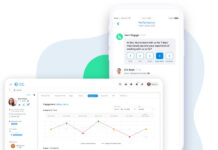
Google the term “executive buy in” and you’ll get about 80,000 results, most of which–according to our unscientific review–relate to winning leadership support for one kind of corporate initiative or another.
We weren’t particularly surprised. Throughout the year, we’ve noticed an increasing penchant among vendors, HR leaders, bloggers and others involved in HCM technology to stress the need for “buy in” when it comes to implementing social recognition, learning, engagement and other programs that are more about recruiting and retention than compliance and HR’s nuts and bolts.
However, there’s a misalignment here: Colloquially, getting leadership “buy in” generally means convincing executives to go along with your strategic, tactical and technical plans. What’s striking is that when we speak to experts in engagement and culture, they talk about “buy in” when they’re really describing an absolute need for executive “passion,” “fervor,” “dedication” and “commitment.”
Are we picking a linguistic nit? We don’t believe so, especially after one consultant told us, “Saying ‘buy in’ minimizes the commitment” that’s needed from the organization’s leadership if engagement and cultural programs are going to succeed. Engagement, he reminded us, “is vital to making culture work, to understanding the community. It directly drives innovation.”
“Saying ‘buy in’ minimizes the commitment” that’s needed from the organization’s leadership if engagement and cultural programs are going to succeed.
So, “obtaining buy in” is like getting the boss to say, “Sure, that’s fine with me,” when you really want them to jump out of their chair and get the program moving. Time after time, we hear HR practitioners and leaders say their engagement programs only succeed when the CEO is leading the charge. They don’t just go along with it, they invest time, money and political capital into it.
These are the executives who send anniversary with personal notes to every employee, who make it a point to visit warehouses as well as offices, who stop by cubicles and introduce themselves, who don’t just take questions during town halls but actually follow up on them. The ones who merely go through the motions do more harm than good. A worker at one company said they’ll never forget when their division head sent him a $20 Starbucks gift card along with a note thanking him for all his hard work in Sales. It would have been a nice gesture, except this gentleman worked in Operations. The attaboy was meant for a sales person who shared his first name. A simple enough mistake, perhaps, but one that impacted the engagement of two senior employees.
Excitement Down, Excitement Up
The idea of executives leading the way on engagement touches every aspect of your program, including whatever technology you use to facilitate it. Much has been written about identifying a platform that works for the rank-and-file and middle management, but it has to appeal to senior leadership, as well.
Feedback apps carry an extra kick when workers know the CEO or division chief use them just like everyone else.
By that, we mean executives have to like it enough to use it. Feedback apps carry an extra kick when workers know the CEO or division chief use them just like everyone else, and that’s even before we get into the idea of a store clerk getting reward points from higher up. Also, seeing executives use the same tools as the rest of the workforce is one of those little details that add up to real engagement.
The danger surfaces when executives try to drive the product selection when they’re not the driving force behind engagement. In those cases, HR must navigate tricky waters, building the CEO’s enthusiasm for engagement while ensuring the tools used are the ones most appropriate for the wider workforce. It’s a balancing act HR regularly confronts: Convincing the C suite’s occupants that not everyone works in the same way they do, under the same conditions, with the same degree of sophistication.
Look to Vendors for Proof
Vendors should be able to help here. After all, they’ve deployed their solutions before and have real-world data on user behaviors and results. These can help you align the needs of both executive and staff users along with your engagement program’s goals.
If a vendor candidate is stingy with its data, be wary. Measurement is critical to successful engagement, and the more you can learn how the involved technology has actually been used, the better. It will help prove, for example, that since 60 percent of your workforce is composed of field technicians, you need apps that may not be the slickest things around but are easier to use at outdoor work sites and in inclement weather. Tech usability is an important piece of the engagement puzzle, and even the most excited executives can push your efforts off-course if they don’t understand why every component must be as frictionless as possible.
That’s why this whole discussion of “excitement” versus “buy in” applies to the workforce as well as the executive. If company leaders aren’t ready to live for engagement, the effort will feel artificial, at best. If employees can’t easily give and receive feedback, take flash polls and share information, your landscape will be uneven and the results of your efforts less than stellar.
Our point is that engagement only works when an organization embraces it. “Buying in” isn’t enough. It’s human nature that the language we use impacts how effectively we communicate. For your program to work, in both the technical and personal sense, stop talking at buy in and start talking about excitement.
Image Copyright: kentoh / 123RF Stock Photo















